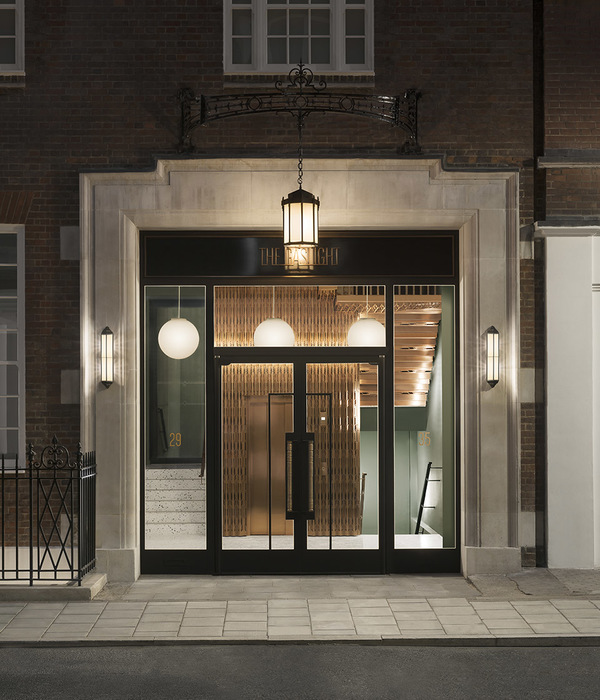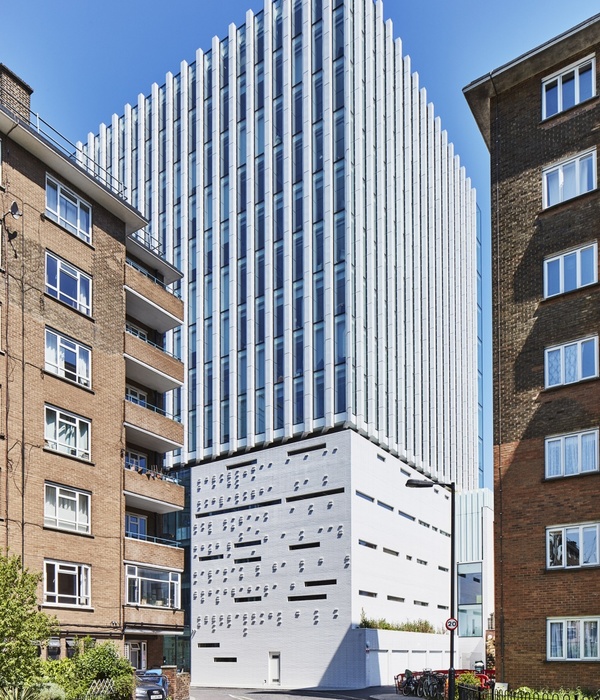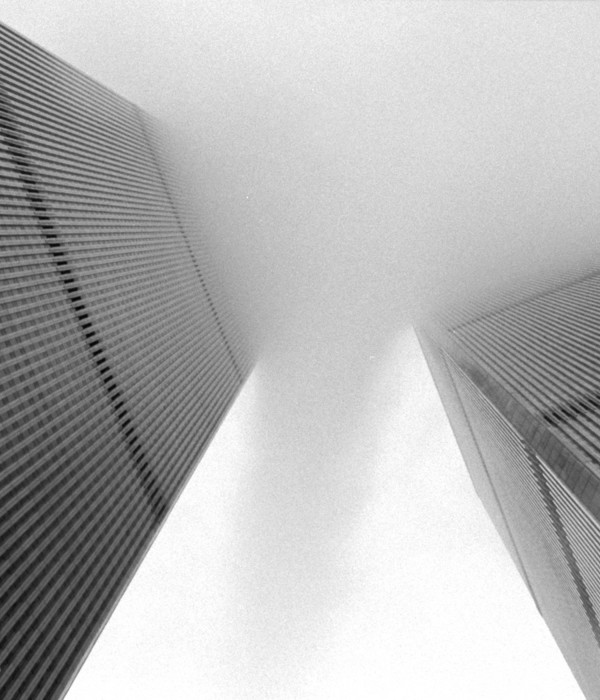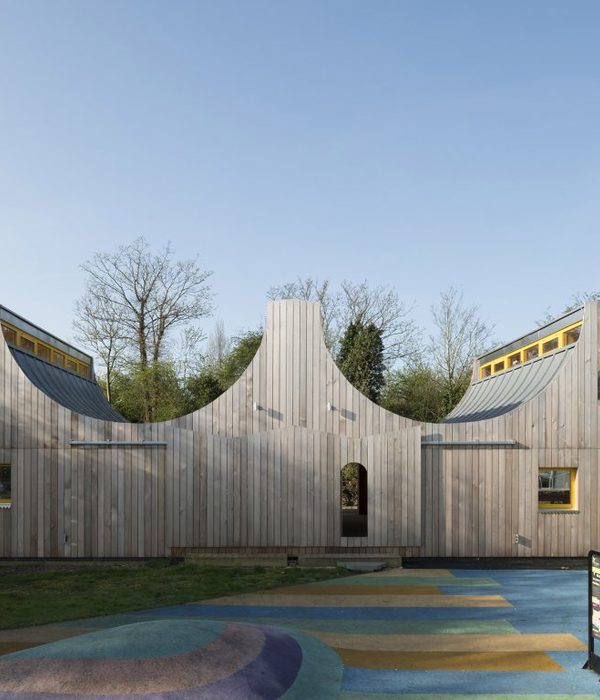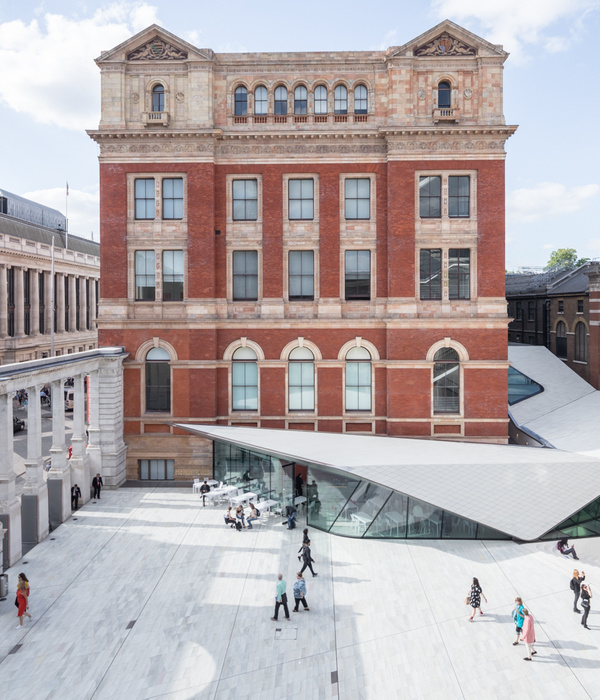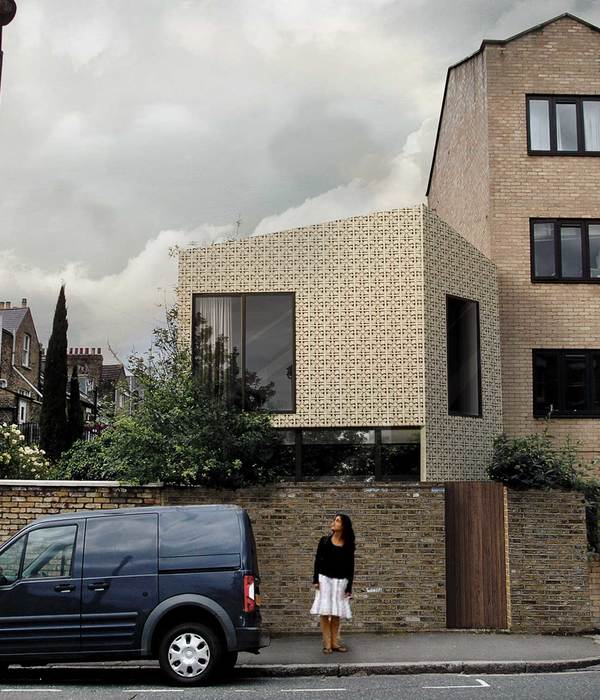位于道岛江和土木里江之间的大阪中之岛沙洲,自中世纪以来一直是贸易和商业活动的繁荣胜地。设计团队通过对场地的调查了解到,该场地是连接中之岛东西两侧的重要纽带,因此,连接人流和并将人流向各个方向引导是设计中非常重要的一环。在本项目中,建筑师并没有选择在场地前设置一条特定的路线,而是通过创造一系列入口来迎接来自四面八方的人们。
Osaka Nakanoshima, a sandbank lying between two rivers, the Dojima River and the Tosabori River, has been a thriving area for trading and commercial activities since the Middle Ages. Through site investigation, it was understood that the site was an important nexus between the east and west sides of Nakanoshima, thus, making it important to connect the flow of people and guide them in all directions. For this reason, instead of having a “front” of the building to create a specific route, a series of entrances were designed to welcome people in all directions.
▼项目概览,Overall of the project
此外,由于中之岛地区面临洪水的风险,美术馆需要将与艺术相关的空间设在三楼及以上,以保护重要的藏品避免洪水造成的破坏。另一方面,建筑底部两个楼层则对城市开放,作为公共空间,并定期供博物馆游客以外的人使用。
Moreover, as the Nakanoshima area is at risk of flooding, it was important to locate the artwork-related rooms on the 3rd floor and above, where damage from flooding could be physically avoided. The 1st and 2nd floors, on the other hand, were open to the city and offer a public space that could be used on a regular basis by people other than visitors to the museum.
▼东北侧外观,Exterior of north-east side
▼开放的城市草坪,Lawn open space
建筑共包含五个楼层,主要采用了钢制框架结构,并带有基础隔离系统以及带有抗震系统的停车场,停车场与主体建筑地基之间设有伸缩缝。底部两层的外部空间与周围景观相连,进而提升美术馆在城市之中的可达性。为了实现美术馆与城市的无缝连接,设计团队采用了一系例策略来消除建筑与周围场地的高差。
▼场地剖面图,section of the site
The project consists of a 5-floors steel frame structure with a base isolation system and a parking space with an earthquake-resistant system, linked by expansion joints. The external spaces on the 1st and 2nd floors are continuous to the surrounding landscape, being conscious of enhancing urban accessibility. In order to make a seamless connection, it was necessary to eliminate the height difference to the surrounding site.
▼停车场及屋顶草坪,Parking lot and rooftop lawn space
美术馆的黑色外墙由609块预制混凝土板组成,表面填充了建筑混凝土、岩手根正碎石、京都宇治的碎砂、黑色颜料,以及JIS标准的轻质混凝土背衬。硬化表面随后会经过超高压水射流的粗糙处理,然后涂上高度浓缩的无机二氧化硅基化合物层,以增强材料的耐候性防止骨料掉落。
The black exterior of the museum is made up of 609 precast concrete plates and the surface is filled with architectural concrete, a combination of crushed Iwate Gensho stone, crushed sand from Uji, Kyoto, black pigment, and a JIS standard lightweight concrete backing. The hardened surface is then roughed up by ultra-high pressure water jets before being coated with a highly concentrated inorganic silica-based compound layer to give weather resistance and protection from aggregates falling.
▼东侧外观,Exterior of east side
▼北侧外观,Exterior of north side
最终,建筑师在底部两层的基础上,设计了一个尺度巨大、轮廓清晰的立方体几何体量,美术馆主体因此仿佛漂浮在城市上空。建筑的二层与场地地形融为一体,通过人行道平台与周围的公共设施相连。此外,一条连接走道延伸到建筑的西侧,进一步将美术馆与城市连接起来,为中之岛地区未来的活力和交通便利做出了贡献。
As a result, on top of the “typography” of the 1st and 2nd floors, a clear geometric “architecture” with massive square facades were designed to express the museum as a floating formation in the city. The 2nd floor, which is a part of the terrain, is connected to the surrounding public facilities by a walkway deck. A connecting walkway is planned to be further extended to the west side of the building, contributing to the future liveliness of the Nakanoshima area and the ease of getting around.
▼东南侧台阶,Stairs of south-east side
▼黑色体量漂浮于街道上方,
Black volumes float above the street
▼立面细部,Details of the facade
三维立体通道
Three-dimensional passages
考虑到场地周围环境,底部两层被规划为公共大堂空间,类似于车站的大厅。贯穿二楼到四楼的自动扶梯将游客从大堂的水平视野体验转换为垂直视野,然后将人们引导进入展厅。内部交通系统的设计方式是将巨大的主楼体量从中掏空,进而形成了一个联系各个楼层的三维立体大厅。大厅具有丰富的空间形态,在四楼主要成东西走向,上升到五楼时,则转变为南北走向。通道的截面则定义了建筑四个立面上的开口形态。
▼底层公共大堂空间,1st floor, Hall
▼底层会议大厅内景,1st floor, Hall interior
▼通往美术馆二层的宽大楼梯,1st floor, Stairs
Considering the surroundings of the site, the 1st and 2nd floors are planned as public lobby spaces, similar to the concourse of a station. The escalator from the 2nd to the 4th floor takes visitors from the horizontal view of the 1st and 2nd floor to the vertical experience of the upper floors, where they then enter the exhibition rooms. The Passage has been designed in such a way that the space is hollowed out from a large volume, creating a three-dimensional lobby space layered on each floor, changing its direction from east to west on the 4th floor and from north to south on the 5th floor. The cross-section of the passages is also the form of the openings in the four exterior walls.
▼二层大厅与交通空间,2nd floor, Passage
▼交错的楼梯营造出丰富的空间序列,The staggered staircases create a rich spatial sequence
▼二层大厅城市视野,View from the 2nd floor entrance
上层通道不仅形成了展厅的前厅,通道形成的立面开口还为人们提供了四个不同方向的城市全景视野。纵横交错的通道穿插于展厅之间,让参观者们在观看展览的同时也能够仰望城市,进而创造一种超越单纯艺术享受的全新城市体验。
▼剖透视图,perspective section
These passages on the upper floors not only function as lobbies in front of the exhibition rooms but also provide views of the Nakanoshima area from all four sides of the building, as the passages intersect in all directions. It is intended that the passages between the exhibition rooms will create opportunities for visitors to look up at the city while viewing the exhibition, creating a new urban experience that goes beyond the mere enjoyment of art.
▼三维立体交通空间,Three dimensional passage space
▼四层通道大厅,4th floor, Escalator
▼四层大厅水平视角,Horizontal view of the hall on the 4th floor
▼五层走道连廊,5th floor, Passage
拥抱生活的设计
A design of embracing life
立面材料经过雕刻,形成微妙的色彩变化,使建筑外观呈现出更加深邃的黑色,这种效果由光影形成,而不仅仅依赖于材料本身的色调。相反,内部通道的墙壁和天花板上则采用了铂银百叶饰面。百叶饰面本身的设计十分简洁,但在略带红色的灰色背景漆、来自中庭顶部光线的自然光以及不同色温的室内灯光的映衬下,却为通道大厅带来了微妙的色彩变化与独特的光影效果。
The surface is carved to create micro-shades, giving the exterior a darker black, without relying on the color of the material. On the contrary, the interior passages are finished with platinum silver louvers on the walls and ceiling. The louvers themselves are very simple, but the effect of the slightly red-tinged gray background paint, the natural light from the top light in the atrium and the different color temperatures of the interior lighting give each side of the passage a unique shade.
▼四层大厅概览,Overall of the 4th floor
▼四层大厅楼梯坡道,4th floor, Stairs
▼四层大厅的城市景观视野,City view from the 4th floor, Exhibition Lobby
当光线穿过黑色立面的开口倾泻在美术馆中,一种仪式感油然而生,象征着人类的活动与发展同文化与艺术紧密相连。
The light pouring through the openings of the black exterior walls is both a symbol and a sign of human activity expressed in relation to art and culture in Nakanoshima, Osaka.
▼中央楼梯井的光影效果,
Passage-Central Stairwell
▼展厅,Exhibition hall
▼夜景,Night view
▼总平面图,site plan
▼一层平面图,1st floor plan
▼二层平面图,2nd floor plan
▼四层平面图,4th floor plan
▼五层平面图,5th floor plan
▼立面图,elevations
▼剖面图,section
Project name (Japanese): 大阪中之島美術館
Project name (English): Nakanoshima Museum of Art, Osaka
Purpose: Art Museum
Location(prefecture, city): Kita-ku, Osaka
Site area: 12,870.54㎡
Total floor area: 20,012.43㎡
Number of floors: five above ground
Structure: Steel frame, Base isolation system
Completion month/year: June, 2021
Client name (Japanese): 大阪市
Client name (English): Osaka City
Lead architect: Katsuhiko Endo
Design Architecture: Katsuhiko Endo Architect and Associates
Structure: Jun Sato Structural Engineers Co., Ltd.
Engineering: Tohata Architects & Engineers
Landscape: Studio Terra, Inc.
Design and supervision: Katsuhiko Endo, Koyo Tonosaki, Fumiaki Kimura, Atsushi Mochinaga, Hisashi Higuchi, Yuui Kishimoto, Yusuke Mizukawa
{{item.text_origin}}



